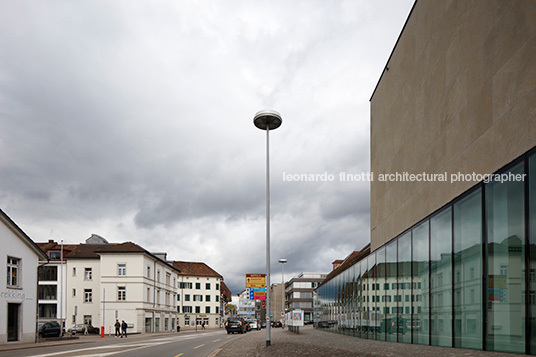extension of the aargauer kunsthaus aarau ag, switzerland
- tech chart
- Expansion of the Aargauer Kunsthaus Aarau, Switzerland; Competition 1996-1997, project 1998-1999, realization 2001-2003 Herzog & de Meuron Team: Partners: Jacques Herzog, Pierre de Meuron, Harry Gugger Project Architect: Philippe Fürstenberger (Associate), Giorgio Cadosch, Carmen Müller Project Team: Adrian Boss, Nicholas Lyons, Philipp Schaerer Competition: Partner: Jacques Herzog, Pierre de Meuron, Harry Gugger, Christine Binswanger Project Architect: Reto Oechslin Project Team: Konstanze Beelitz, Hans-Ulrich Matter, Abigail Pearson In Collaboration with: Rémy Zaugg, Basel, Switzerland Client: Baudepartement des Kantons Aargau, Abteilung Hochbau, Aarau, Schweiz Planning: General planning: ARGE Herzog & de Meuron / Proplaning AG, Basel, Schweiz Structural Engineering: Walter Mory Maier, Bauingenieure AG, Basel, Schweiz HVAC Engineering: Waldhauser Haustechnik AG, Basel, Schweiz Plumbing: B. Friedrich, Zürich, Schweiz Electrical Engineering: EAG, Basel, Switzerland Landscape Design: August Künzel, Binningen, Schweiz Specialist / Consulting: Facade Consultant: Emmer, Pfenninger + Partner, Münchenstein, Schweiz Structure Physics: Gartenmann Engineering AG, Basel, Schweiz Lighting: Ove Arup & Partners, Consulting Engineers, London, UK Acoustics: Martin Lienhard, Langenbruck, Schweiz Building Data: Expansion: Length 56m, Width 25m, Height 5.8m Building Footprint: 1,200sqm Gross Floor Area: 2,500sqm Old Exhibition Area: 1,803sqm New Exhibition Area: 2,950sqm www.aargauerkunsthaus.ch
- description
Park and museum
Two salient urban features define the space in the immediate environs of the Aargauer Kunsthaus: the historical ensemble of government buildings with their expansive staircases and terraces, and the spacious, wooded park, originally hidden behind the Kunsthaus and the cantonal library. The relationship between these elements has been clarified, enabling them to become effective as architecture. Our proposal for the extension of the Kunsthaus is thus based on fundamental concerns of urban development. Now that the extension is complete the park continues down to the Bahnhofstrasse and the Kunsthaus reaches into the park, thus park and museum form a whole, where the park has become part of the museum and the museum part of the park.The extension to the Kunsthaus is conceived as an elevated terrace. This elevated and planted urban terrace might be called topographical architecture. There are well-known historical antecedents, such as the pedestal of the Albertina in Vienna, the greenhouse terraces at Sanssouci Palace in Potsdam or the terrace of the Villa Doria in Rome. A topographical, landscaping element of this kind is formed by the raised square of plane trees in front of the neighboring parliament building. This square is now logically complemented and completed by the terrace of the museum extension.
The extension of the Kunsthaus symmetrically frames the west side of the government building, thereby strengthening the status of the Aargauerplatz. The idea of overcoming the topographical difference in height by means of a flight of stairs, as in the government building, has been applied to the new extension of the museum. The shape of the stairs relates to the iconic circular staircase of the old museum. But the new stairs – themselves a kind of sculpture that marks the new main entrance – also function in many respects like an articulated link.
The crystalline interior of the lobby is conceived as an artificial cave or grotto, once again a motif from the iconography of garden architecture. This sculpturally shaped interior space actually marks the end of the park facing the city while opening up and establishing a link with the interior of the museum as well.
Pedestals of various architectural shapes characterize both the rustically designed, historical government building as well as the Kunsthaus of 1956. The extension takes up this motif, using pedestals to link the various parts of the building on site.
It unites solid construction with glass structures; transparent glazing alternates with solid, glass-clad sections of walls. Room-height windows in the exhibition spaces and the lobby open the building to view inside and outside. At dusk, the pedestal becomes a body of light, a focus of attention in the public urban space of Aarau.
Exhibition spaces
The existing Aargauer Kunsthaus has a clear arrangement of differently illuminated exhibition spaces: a space with overhead illumination on the second floor; a space with lateral illumination on the ground floor; and a space with artificial illumination on the lower level. The new extension adds to this simple, clear-cut and effective use of space and light without interfering with it. A new laterally illuminated space will adjoin the existing one; a new space with artificial light will be built on to the existing one, and with exactly the same dimensions.The curators will have at their disposal a great variety of exhibition layouts, concepts, and means of subdividing the spaces. In addition, each of the floors can be used as a single, open-plan space with homogeneous lighting.
The glazed inner courtyard will become the center of the remodeled Aargauer Kunsthaus. It also provides an atrium for the ground floor exhibition spaces. Parts of the glazed walls can be closed off from inside to meet curatorial needs. The courtyard itself can also be incorporated in the exhibitions, thus adding space to the interior of the museum.
Herzog & de Meuron, 2006








































